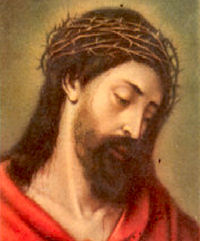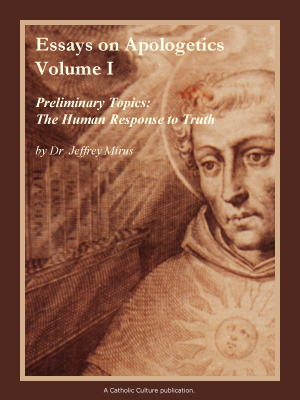Lent: March 13th
Thursday of the Fifth Week of Lent
Other Commemorations: St. Roderick, Martyr (RM); St. Leander of Seville, Bishop (RM);
» Enjoy our Liturgical Seasons series of e-books!
Jesus said to the Jews: "I tell you most solemnly, whoever keeps my word will never see death."
The Jews said, "Now we know for certain that you are possessed. Abraham is dead, and the prophets are dead, and yet you say, "Whoever keeps my word will never know the taste of death." Are you greater than our father Abraham, who is dead? The prophets are dead too. Who are you claiming to be?" Jesus answered: "If I were to seek my own glory that would be no glory at all; my glory is conferred by the Father, by the one of whom you say, 'He is our God' although you do not know him."
The rulers and Pharisees of the Gospel made no effort to grasp Our Lord's teaching but sneered at His remarks. Hene Our Lord said to them that they will neither share in the divine life nor come to the glories of the resurrection and of eternal life. He who, on the other hand, accepts the truths of faith and mortifies himself, lives in such intimate union with God that it becomes a foretaste of heaven.
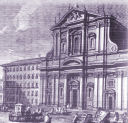
The Station in Rome is in the church of St. Apollinaris, who was a disciple of St. Peter, and afterwards bishop of Ravenna. He was martyred. The church was founded in the early Middle Ages, probably in the 7th century.
Meditation - The Eloquence of Jesus' Silence
How singularly majestic must have been the eloquence of Jesus, when as a boy He sat among the doctors of the law in the temple, or when He thrilled the multitudes, commanded the winds and waves, and put to flight diseases and demons and death itself! Yet, perhaps nowhere else did the majesty of His eloquence reveal itself, as it did in that heroic calm and consistent silence, which reached its climax in the three hours of His agony.
But what should strike us most forcibly, and yet most sweetly, is the interior silence of Jesus, the silence of His innermost soul and heart, of His human passions, of His feelings and thoughts and fancies. Recall the word of Jesus, that from the heart come forth evil works, bitter zeal, and false testimonies and blasphemies (Matt. 15:19); and then dwell on His own strikingly consistent example of quashing all bitterness and quenching all the fires of passion, and of refraining from impatience, anger, and retaliation, even when tongues all around were busy kindling fires of hateful calumnies against His truest self-knowledge and wounding His livest self-respect.
Hence, pray that you may see deep into the interior soul of Jesus, there to realize the true majesty and marvelous eloquence of the silence of His lips and tongue, the silence which was the fruit of His charity and of the interior peace and perfection of right order that ever reigned within the sanctuary of His heart, the silence which was the precious fruit of the obedience and humility in His absolute abandonment to the mysterious providence of His Father in heaven.
— Our Way to the Father by Rev. Leo M. Krenz, S.J.
St. Roderick of Cordoba
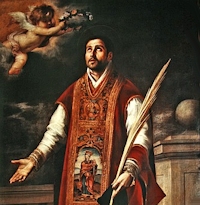 Jesus warned his disciples that they should expect no better treatment than Himself. They would be haled before governors and kings on His account, and brothers would even hand brothers over for execution.
Jesus warned his disciples that they should expect no better treatment than Himself. They would be haled before governors and kings on His account, and brothers would even hand brothers over for execution.
That prophecy was literally fulfilled in the case of St. Roderick, a Spanish martyr who died at the hands of the Muslim Moors in A.D. 857. His was a bitter case of the reverse of Christian love. We owe the account to eyewitness St. Elogius, who later on died for the faith himself.
It must be admitted that when the Mohammedans invaded Spain in A.D. 711, even they were sometimes shocked by the lack of religious principles among a large number of the Hispanic Christians. As the Moors swarmed in, the Catholics, far from presenting a strong front, became divided. Many, whether out of fear or lack of faith, voluntarily gave up their Christianity. Families thus split asunder and the members on either side railed at each other.
St. Roderick was to prove a sad victim of this sort of betrayal. He was a good priest of Cabra who had two irresponsible brothers. One of them was a bad Christian who had all but abandoned his faith. The other had gone still further and joined Islam. One night the two started to fight each other unmercifully. Roderick tried to break them up, but instead of yielding, they turned on him and beat him senseless. Then the Muslim brother had the priest put on a litter and carried half-conscious through the streets. The Muslim accompanied the bier, proclaiming that Father Roderick, too, had apostatized, and that he wanted it known publicly before he died. Eventually the victim did recover and went off to a safe place.
But Father Roderick had not yet seen the last of his renegade brother. The Muslim met the priest soon afterwards in the streets of Cordova. He had Roderick taken at once before the Mohammedan kadi (judge), where he accused him of the crime of having returned to Christianity after public profession of his Muslimism.
Although Father Roderick protested that he had never denied his Christian faith, the kadi clapped him into the city's worst dungeon.
In that fetid jail, the priest at least had the comfort of finding one Solomon, another Christian prisoner who had been accused of the same "unforgiveable" crime. Both of them were given a long term of imprisonment, in the hope that they would convert. But each man encouraged the other, and they remained firm in their Christian convictions. Even when separated, they would not change their belief.
Eventually, the kadi ordered the Catholic priest and the layman beheaded. St. Eulogius saw their headless bodies lying on the riverside. He noticed that the guards were careful to throw into the stream any stones stained with the men's blood, for fear the faithful might pick them up as relics.
The soldiers sought in vain to ward off veneration of SS. Roderick and Solomon. Spanish Christians would always honor them thereafter as martyrs. And they would also gradually learn from this heroism that the Faith is something really worth dying for.
—Father Robert F. McNamara, Excerpted from St. Kateri Tekakwitha Parish
Symbols and Representation: priest in Mass vestments holding a palm of martyrdom as an angel brings him a wreath of roses
Highlights and Things to Do:
- Read more about St. Roderick:
- Read The Islamic Warriors' Destruction of a Nascent Civilization: the Catholic Kingdom of the Visigoths in Spain (A.D. 589–711) which appeared in the Winter-Spring 2011 issue of Modern Age to gain an understanding of the times in which St. Roderick lived.
St. Leander of Seville
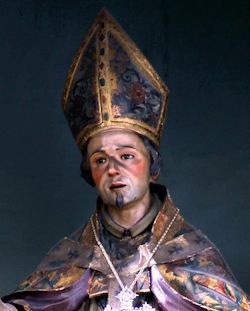 St. Leander was born of an illustrious family at Carthagena in Spain. He was the eldest of five brothers, several of whom are numbered among the Saints. He entered into a monastery very young, where he lived many years and attained to an eminent degree of virtue and sacred learning.
St. Leander was born of an illustrious family at Carthagena in Spain. He was the eldest of five brothers, several of whom are numbered among the Saints. He entered into a monastery very young, where he lived many years and attained to an eminent degree of virtue and sacred learning.
These qualities occasioned his being promoted to the see of Seville; but his change of condition made little or no alteration in his method of life, though it brought on him a great increase of care and solicitude.
Spain at that time was in possession of the Visigoths. These Goths, being infected with Arianism, established this heresy wherever they came; so that when St. Leander was made bishop it had reigned in Spain a hundred years. This was his great affliction; however, by his prayers to God, and by his most zealous and unwearied endeavors, he became the happy instrument of the conversion of that nation to the Catholic faith. Having converted, among others, Hermenegild, the king's eldest son and heir apparent, Leander was banished by King Leovigild. This pious prince was put to death by his unnatural father, the year following, for refusing to receive Communion from the hands of an Arian bishop. But, touched with remorse not long after, the king recalled our Saint; and falling sick and finding himself past hopes of recovery, he sent for St. Leander, and recommended to him his son Recared. This son, by listening to St. Leander, soon became a Catholic, and finally converted the whole nation of the Visigoths. He was no less successful with respect to the Suevi, a people of Spain, whom his father Leovigild had perverted.
St. Leander was no less zealous in the reformation of manners than in restoring the purity of faith; and he planted the seeds of that zeal and fervor which afterwards produced so many martyrs and Saints.
This holy doctor of Spain died about the year 596, on the 27th of February, as Mabillon proves from his epitaph.
The Church of Seville has been a metropolitan see ever since the third century. The cathedral is the most magnificent, both as to structure and ornament, of any in all Spain.
—Excerpted from Lives of the Saints, by Alban Butler, Benziger Bros. ed. [1894]
Patronage: Seville, Spain
Highlights and Things to Do:
- Read more about St. Leander:
- St. Leander was one of several saints in his family. He was the elder brother of Saint Isidore of Seville, Saint Fulgentius of Ecija, and Saint Florentina of Cartagena.
- The Cathedral of Murcia has a silver urn that contains the remains of the four sibling saints.


